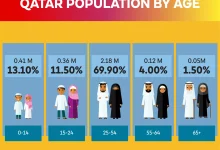Libya, located in North Africa, is a country with a unique socio-political landscape and a diverse demographic profile. As of the latest estimates before 2022, Libya had a population of approximately 7 million people. This figure is derived from various sources, including demographic studies, census data, and projections made by international organizations such as the United Nations and the World Bank.
The demographic structure of Libya reflects a combination of historical, cultural, and socio-economic factors. The majority of the population is of Arab-Berber descent, with Arabic being the official language. There are also smaller communities of Tuareg, Toubou, and other ethnic groups, contributing to the country’s rich cultural mosaic.
Libya’s population growth has been influenced by several factors, including fertility rates, migration patterns, and economic conditions. Historically, Libya experienced a high population growth rate, largely driven by high fertility rates. However, political instability and economic challenges in recent years have affected demographic trends and migration patterns.
One of the significant demographic aspects of Libya is its urbanization. The majority of the population resides in urban areas, with cities such as Tripoli, Benghazi, and Misrata being major population centers. These urban areas are hubs of economic activity, administrative functions, and cultural life. In contrast, the vast majority of Libya’s land area is sparsely populated, with large expanses of desert and sparsely inhabited rural areas.
Tripoli, the capital and largest city, serves as the political and economic heart of the country. It is home to a significant proportion of Libya’s population and is a central point for administrative, economic, and cultural activities. Benghazi, located in the east, is another major city and an important center for trade and industry. Misrata, situated in the northwest, also plays a crucial role in Libya’s economy, particularly in the industrial and commercial sectors.
Libya’s demographic profile has been shaped by historical events, including the Italian colonization in the early 20th century, the subsequent independence in 1951, and the long rule of Muammar Gaddafi from 1969 to 2011. The political upheaval and civil conflict following Gaddafi’s ousting in 2011 have had a profound impact on the country’s demographics. These events have led to internal displacement, migration, and changes in population distribution.
Migration has played a significant role in shaping Libya’s demographic landscape. The country has been a destination for migrants from various regions, including sub-Saharan Africa, seeking employment opportunities and better living conditions. Migrants often work in sectors such as construction, agriculture, and domestic services. Additionally, Libya has been a transit point for migrants attempting to reach Europe, particularly during periods of heightened conflict and instability in the region.
The Libyan government, in collaboration with international organizations, has made efforts to address demographic challenges and improve living conditions for its citizens. These efforts include initiatives to enhance infrastructure, healthcare, and education, as well as programs to address the needs of displaced populations and migrants.
The population dynamics of Libya continue to evolve, influenced by ongoing political developments, economic conditions, and social changes. As the country navigates its path toward stability and development, demographic trends will play a crucial role in shaping its future.
In summary, Libya’s population, estimated at around 7 million before 2022, reflects a diverse and evolving demographic profile. The country’s historical, cultural, and socio-economic factors have contributed to its unique population structure, with significant urbanization, migration patterns, and impacts from political instability. Understanding these demographic aspects is essential for addressing the challenges and opportunities facing Libya as it continues to develop and progress.

